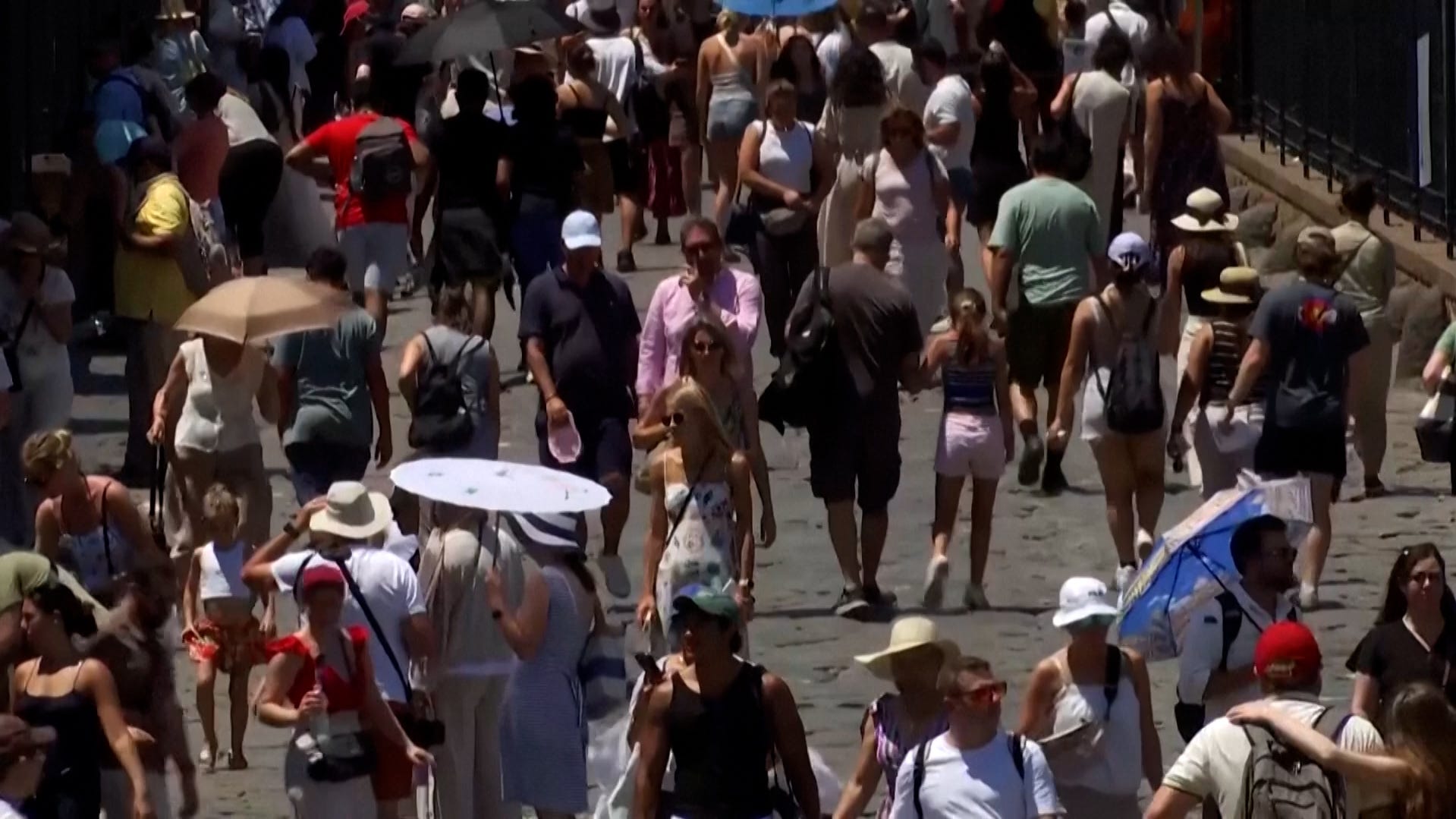Temperatures climbed above 100 degrees Fahrenheit across parts of Europe, creating health concerns and closing historic landmarks.

European countries battle severe heat wave
As locals and tourists enjoy the European summer, they’re also battling extremely high temperatures.
A sweltering heat wave sent temperatures soaring above 100 degrees across much of Europe, causing schools and landmarks to shutter as several countries recorded the hottest month of June on record and forcing a temporary rules change at Wimbledon.
France issued a red alert on July 1 and warned of potentially severe health impacts as temperatures across the country climbed to between 100 and 104 degrees Fahrenheit, according to the country’s meteorological service. The agency said it anticipates Tuesday will be among the 10 hottest days ever recorded in France.
The blistering temperatures caused one of the world’s most popular tourist attractions, the Eiffel Tower, to close its top floor, shorten its hours and turn away visitors who don’t have advanced tickets.
In Belgium, where temperatures reached the high 90s, officials closed the Atomium attraction, a model of an iron molecule built for the 1959 Brussels World’s Fair. It is only the second time the model changed hours because of heat. The first was in 2019.
Italy, meanwhile, issued heat wave red alerts across 17 cities, including Milan and Rome. Several regions of the Mediterranean country banned outdoor work during the hottest hours of the day.
The extreme heat across the western Europe is the result of a heat dome. That’s a common summer weather pattern that produces high pressure and acts as a cap, locking heat in underneath, France’s weather service said.

Zoo animals have fun keeping cool in European heatwave
As temperatures climbed across Europe, zookeepers worked to keep animals cool.
Heat breaks record on Wimbledon opening day
Fans and athletes alike sweltered under record hot conditions for opening day of the Wimbledon Championships, when temperatures topped out at over 90 degrees on June 30.
The All England Club said the air temperature, confirmed by the French meteorological administration Meteo France, eclipsed the previous opening-day high of 84.7 degrees, set in 2001, Reuters reported. The record-high temperature for the entire tournament – 96.3 degrees – was set in 2015.
Wimbledon’s “Operation Ice Towel” is in big demand, with last minute preparations before the start of play to increase orders for ice and white towels and procure space in a freezer normally used for food and beverages, Wimbledon.com reported. The white towels, rolled up with a line of ice cubes, are made available to players during changeovers and breaks that are allowed under Wimbledon’s heat rules once temperatures reach a certain level.
Ninth-seeded Daniil Medvedev of Russia, asked for a record number of nine additional ice towels before his ultimate defeat to Benjamin Bonzi during a more than 3-hour game on June 30, Wimbledon.com reported.
“Physically it was not easy … I mean, I’ll never say he won because of the heat,” Medvedev said, according to Reuters. “But the heat is not easy to play. I do think if you ask him, probably he was not enjoying the heat either.”
England saw its warmest June on record, according to the UK Met Office. Amy Doherty, a climate scientist with the office, said past studies have shown it is “virtually certain that human influence has increased the occurrence and intensity of extreme heat events such as this.”
Parts of Europe set heat records
The scorching temperatures come as Spain, Portugal and England recorded their hottest June last month. The average temperature in Spain was 78 degrees Fahrenheit in June. On June 30, it rose to about 100 degrees, according to the country’s weather service.
Those highs are “exceptional” the World Meteorological Organization said in an online forecast. Europe typically experiences its hottest temperatures of the year in July. The organization cites human-induced climate change as a reason for the extreme heat.
More than two thirds of the continent’s most severe heatwaves since 1950 have occurred in the last 25 years, according to the World Meteorological Organization. By 2050, it expects “half of the European population may be exposed to high or very high risk of heat stress during summer.”
The agency said the punishing temperatures could cause severe, potentially life threatening, effects on human health.
And many people can’t seek shelter from the heat at home: As of 2019, only 20% of households in Europe had air conditioning installed, according to the European Environment Agency.
Western US sees scorching temps
Parts of the United States are also being gripped by higher-than-normal temperatures.
The National Weather Service issued an extreme heat warning for parts of southwest Arizona and southeast California until 8 p.m. on July 1. Afternoon highs could reach between 110 and 115 degrees Fahrenheit in these regions, according to the agency
Washington, Oregon, Idaho, Montana, Nevada and Utah are all expected to see temperatures around 100 degrees Fahrenheit. The weather service issued heat advisories through the evening of July 2 for much of those states, warning people to take extra precautions when outside.
The agency also issued a red flag warning for much of northern California and north-central Nevada, meaning that “critical fire weather conditions are either occurring now, or will shortly.” These can include a “combination of strong winds, low relative humidity, and warm temperatures can contribute to extreme fire behavior.”
“Heat will build over the Intermountain West and the Southwest the next couple of days,” the National Weather Service said in an online forecast on June 30. “Lightning from dry thunderstorms can create new fire starts and combined with gusty winds may cause a fire to rapidly grow in Oregon and northern California.”
Contributing: Dinah Voyles Pulver and Doyle Rice, USA TODAY; Reuters








